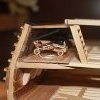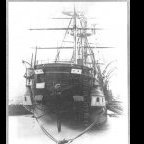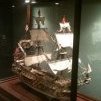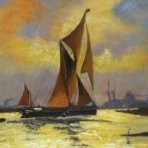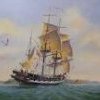MORE HANDBOOKS ARE ON THEIR WAY! We will let you know when they get here.
×
-
Posts
3,550 -
Joined
-
Last visited
Reputation Activity
-
 yvesvidal reacted to Lecrenb in St Roch by Lecrenb - 1:48 scale - RCMP Schooner rigged as schooner c. 1930/35
yvesvidal reacted to Lecrenb in St Roch by Lecrenb - 1:48 scale - RCMP Schooner rigged as schooner c. 1930/35
I got the rudder and tiller attached to the dinghy, also the lifting lugs (which won't be seen once the cover is on) and it is now ready for paint. I'll set it aside until the motorboat is ready then I'll shoot them both together...
I sourced some silkspan from a friend on another modelling site, so once it arrives I'll start marking out the sails per David Antscherl's Sphinx Appendix volume.
That is getting ahead of myself, however I want some silkspan offcuts to make covers for the dinghy and motorboat.
Meanwhile the dinghy's chocks are finished and glued in place on the deck and cap rail, per the ship's plans. I still have to add the braces, but the re-routed steering cables are now in the way, so I will have to adjust the braces a bit. I won't remove them, but I have to try and get into the shipwright's heads as they carried out St. Roch's 1930 refit!
A little bit of cleanup on the rail, and I'm also ready for the gripes and davits to be installed... again, I'll hold off a bit, it will be easier to rig these items once the boats are painted and installed.
So there's lots to do to finish the lifeboats, so I'd better stop here and crack on!
Regards,
Bruce
-
 yvesvidal reacted to mikegr in Rebuilding the fleet by mikegr - 1/700 - restoring old plastic models
yvesvidal reacted to mikegr in Rebuilding the fleet by mikegr - 1/700 - restoring old plastic models
Next project is the rear mast.
Some PE parts were incredibly small. I didn't loose anything but managed to loose two spare airbrush noses while trying to replace a clogged one. Fortunately I have spare airbrush as well
Brass was used extensively to make a rigid and durable piece. One thing that made me happy is that I found a way to make strong masts without use of messy soldering. With my low rpm rotary tool and a disc cutter I made a slot, filled it with ca glue and attach thehe yarddam vertically. How come I haven't thing of it early would have saved big mess and effort
-
 yvesvidal reacted to GrandpaPhil in Oryol 1902 by GrandpaPhil - Orel - 1/200 - CARD - Russian Battleship
yvesvidal reacted to GrandpaPhil in Oryol 1902 by GrandpaPhil - Orel - 1/200 - CARD - Russian Battleship
The foremast is pretty much done and only needs yards/davits now:
The aft mast is stepped:
I am not in the habit of gluing masts down.
I usually let the rigging hold them in place.
It seems to work well.
I am presently working on the mast fittings (aka lots of little pulleys):
Here is a side on shot of the model as it stands right now:
I am very happy with how it is turning out!
-
 yvesvidal got a reaction from KennyH78 in Le Chebec by Yvesvidal - CAF Model - 1/48
yvesvidal got a reaction from KennyH78 in Le Chebec by Yvesvidal - CAF Model - 1/48
Finally, planking of the rear quarter deck is completed: 38 + 1 planks, total.
After a fine sanding and a good vacuuming, the deck can be protected with a few coats of Wipe On Poly: You can see how the color changes....
Now is the time to finish some details on the rear deck.
Yves
-
 yvesvidal got a reaction from Canute in Libertad 1925 by Valeriy V - Scale 1:100 - Spanish Type F Light Cruiser
yvesvidal got a reaction from Canute in Libertad 1925 by Valeriy V - Scale 1:100 - Spanish Type F Light Cruiser
I am amazed at how you get that brass polished, especially in the locations of the soldering.
You are so good at metal work that it is not surprising that your model would be made of metal, like the prototypes.
Yves
-
 yvesvidal got a reaction from Desertanimal in Le Chebec by Yvesvidal - CAF Model - 1/48
yvesvidal got a reaction from Desertanimal in Le Chebec by Yvesvidal - CAF Model - 1/48
Finally, planking of the rear quarter deck is completed: 38 + 1 planks, total.
After a fine sanding and a good vacuuming, the deck can be protected with a few coats of Wipe On Poly: You can see how the color changes....
Now is the time to finish some details on the rear deck.
Yves
-
 yvesvidal got a reaction from Thukydides in Le Chebec by Yvesvidal - CAF Model - 1/48
yvesvidal got a reaction from Thukydides in Le Chebec by Yvesvidal - CAF Model - 1/48
Finally, planking of the rear quarter deck is completed: 38 + 1 planks, total.
After a fine sanding and a good vacuuming, the deck can be protected with a few coats of Wipe On Poly: You can see how the color changes....
Now is the time to finish some details on the rear deck.
Yves
-
 yvesvidal reacted to scrubbyj427 in HMS Portland 1770 by scrubbyj427 - 1:48 - 4th rate 50-gun ship
yvesvidal reacted to scrubbyj427 in HMS Portland 1770 by scrubbyj427 - 1:48 - 4th rate 50-gun ship
Hi Ronald,
Thank you, it’s finally starting to look like Portland! I will only plank one or two planks below the wales, leaving the frames exposed as shown on the painting of the contemporary model.
The model requires at least one plank below the wales, the gundeck at the stern is actually below the wales to it would visible through the frames.
-
 yvesvidal got a reaction from ccoyle in Le Chebec by Yvesvidal - CAF Model - 1/48
yvesvidal got a reaction from ccoyle in Le Chebec by Yvesvidal - CAF Model - 1/48
Finally, planking of the rear quarter deck is completed: 38 + 1 planks, total.
After a fine sanding and a good vacuuming, the deck can be protected with a few coats of Wipe On Poly: You can see how the color changes....
Now is the time to finish some details on the rear deck.
Yves
-
 yvesvidal got a reaction from FriedClams in Libertad 1925 by Valeriy V - Scale 1:100 - Spanish Type F Light Cruiser
yvesvidal got a reaction from FriedClams in Libertad 1925 by Valeriy V - Scale 1:100 - Spanish Type F Light Cruiser
I am amazed at how you get that brass polished, especially in the locations of the soldering.
You are so good at metal work that it is not surprising that your model would be made of metal, like the prototypes.
Yves
-
 yvesvidal got a reaction from Keith Black in Libertad 1925 by Valeriy V - Scale 1:100 - Spanish Type F Light Cruiser
yvesvidal got a reaction from Keith Black in Libertad 1925 by Valeriy V - Scale 1:100 - Spanish Type F Light Cruiser
I am amazed at how you get that brass polished, especially in the locations of the soldering.
You are so good at metal work that it is not surprising that your model would be made of metal, like the prototypes.
Yves
-
 yvesvidal got a reaction from Paul Le Wol in Libertad 1925 by Valeriy V - Scale 1:100 - Spanish Type F Light Cruiser
yvesvidal got a reaction from Paul Le Wol in Libertad 1925 by Valeriy V - Scale 1:100 - Spanish Type F Light Cruiser
I am amazed at how you get that brass polished, especially in the locations of the soldering.
You are so good at metal work that it is not surprising that your model would be made of metal, like the prototypes.
Yves
-
 yvesvidal got a reaction from cotrecerf in Libertad 1925 by Valeriy V - Scale 1:100 - Spanish Type F Light Cruiser
yvesvidal got a reaction from cotrecerf in Libertad 1925 by Valeriy V - Scale 1:100 - Spanish Type F Light Cruiser
I am amazed at how you get that brass polished, especially in the locations of the soldering.
You are so good at metal work that it is not surprising that your model would be made of metal, like the prototypes.
Yves
-
 yvesvidal reacted to RGL in Fordson N roadless tractor by RGL - Plus Model - 1/35 - RESIN
yvesvidal reacted to RGL in Fordson N roadless tractor by RGL - Plus Model - 1/35 - RESIN
A few photos
-
 yvesvidal reacted to RGL in Fordson N roadless tractor by RGL - Plus Model - 1/35 - RESIN
yvesvidal reacted to RGL in Fordson N roadless tractor by RGL - Plus Model - 1/35 - RESIN
Because I’m easily distracted, this came up on sale and I love Plus Model stuff; Resin and PE.
-
 yvesvidal reacted to scrubbyj427 in HMS Portland 1770 by scrubbyj427 - 1:48 - 4th rate 50-gun ship
yvesvidal reacted to scrubbyj427 in HMS Portland 1770 by scrubbyj427 - 1:48 - 4th rate 50-gun ship
There is, it’s pearwood/cherry
-
 yvesvidal reacted to Dr PR in USS Cape (MSI-2) by Dr PR - 1:48 - Inshore Minesweeper
yvesvidal reacted to Dr PR in USS Cape (MSI-2) by Dr PR - 1:48 - Inshore Minesweeper
Gary,
Not as nice as it might have been! A lot of things were screwed up pretty badly when the glue set. The angles of the front three panels were way off. I tried to repair the problems, but the "repaired" piece still had a lot of problems.
If at first you don't succeed, try, try again.
The problem seems to have been caused by the side pieces moving back and forth while I was assembling all of the panels and supports for the front of the superstructure. The thing just wasn't rigid enough to hold its shape.
The blueprints show the front panels resting at an 85 degree angle to the deck, and they join each other at 150 degree angles. At the sides they join the deck house sides at approximately a 120 degree angle, but not quite because the house sides are not parallel.
I double checked the deckhouse frame that is glued to the sub deck against a printed template, and all of the angles were correct. Likewise the bridge deck - that rests on the deckhouse sides - also had the correct angles.
But the front panels did not align properly at the top edges with the bridge deck - they were way off in places! There wasn't any way to correct the errors, so the three front panels were chopped out and I started over.
The first thing to do was realign the sides and rear bulkhead to the deckhouse frame and glue it all together.
Then the top rear O1 level deck was glued on. Once this was in place the structure was rigid. This piece is 1/16 inch (1.6 mm) plywood and was pretty stiff. The deck has camber, but no sheer. The interior bulkheads were all cut with the camber, so I needed to bend the plywood to the correct curvature.
I wet the plywood and then bent it over a couple of wooden sticks. The edges were clamped to a very stiff 1/4 inch (6.35 mm) thick piece of aluminum plate. Then the plywood was pre-heated with a hair dryer and the whole thing was placed out into the noon day sun. After a few hours at 80+ Fahrenheit (28 Celsius) the plywood was dry and had adopted a nice camber.
While the glue was setting I added the walls for the small nook in the port side of the deckhouse. There is a scuttle in the main deck here that was the escape route for the forward minesweeping generator engine room.
With the rigid deckhouse structure to work with I devised a simple solution for aligning the front panels. I cut a piece of 1/16 inch (1.6 mm) basswood to match the shape of the front of the deckhouse frame and bridge deck.
After the leading edges of the sides were prepared at the proper angles to mate with the front pieces, the new top front support was glued into place, with a couple of additional supports to strengthen the assembly.
In this photo the deckhouse is upside down and resting on a sheet of waxed paper. I applied an excess of Titebond Original glue to be sure everything was glued together. The waxed paper prevented the deck house from being glued to the work bench. I have had enough problems with this already and don't need for that to happen!
Next I shaped the two side panels to fit the house sides, deckhouse frame and top front support piece. These pieces were cut oversized on all sides and then cut, filed and sanded to fit. Then they were glued into place, and additional support pieces were glued into the angles between the front pieces and the house sides. I wanted these parts to be well supported.
Note that the deckhouse parts are not glued to the deckhouse frame on the main deck. I want to remove the deckhouse while planking the deck, and to continue construction of the O1 level deckhouse and bridge away from the hull.
After the side panel glue had hardened over night I shaped the front panel piece to a tight slip fit between the side panels. Then it was glued into place.
They say the proof of the pudding is in the tasting - or in this case how well the bridge deck fits to the deckhouse structure.
It is as close to a perfect fit as I can get! All of the angles align the way Phil and BuShips intended. I should have assembled it this way in the first place (hindsight is always clearest)!
Now I can start the main deck planking, and while the glue is setting I can do some work on the O1 superstructure (radio room and pilot house) and bridge.
Here are a couple more photos of the main deck deckhouse.
And the deckhouse in place on the hull.
-
 yvesvidal reacted to Valeriy V in Libertad 1925 by Valeriy V - Scale 1:100 - Spanish Type F Light Cruiser
yvesvidal reacted to Valeriy V in Libertad 1925 by Valeriy V - Scale 1:100 - Spanish Type F Light Cruiser
The contours of the model gradually take shape.
-
 yvesvidal reacted to Valeriy V in Libertad 1925 by Valeriy V - Scale 1:100 - Spanish Type F Light Cruiser
yvesvidal reacted to Valeriy V in Libertad 1925 by Valeriy V - Scale 1:100 - Spanish Type F Light Cruiser
Thank you all for your kind comments and likes!!!
-
 yvesvidal got a reaction from scrubbyj427 in Le Chebec by Yvesvidal - CAF Model - 1/48
yvesvidal got a reaction from scrubbyj427 in Le Chebec by Yvesvidal - CAF Model - 1/48
Finally, planking of the rear quarter deck is completed: 38 + 1 planks, total.
After a fine sanding and a good vacuuming, the deck can be protected with a few coats of Wipe On Poly: You can see how the color changes....
Now is the time to finish some details on the rear deck.
Yves
-
 yvesvidal got a reaction from SiriusVoyager in Le Chebec by Yvesvidal - CAF Model - 1/48
yvesvidal got a reaction from SiriusVoyager in Le Chebec by Yvesvidal - CAF Model - 1/48
Finally, planking of the rear quarter deck is completed: 38 + 1 planks, total.
After a fine sanding and a good vacuuming, the deck can be protected with a few coats of Wipe On Poly: You can see how the color changes....
Now is the time to finish some details on the rear deck.
Yves
-
 yvesvidal got a reaction from AJohnson in Le Chebec by Yvesvidal - CAF Model - 1/48
yvesvidal got a reaction from AJohnson in Le Chebec by Yvesvidal - CAF Model - 1/48
Finally, planking of the rear quarter deck is completed: 38 + 1 planks, total.
After a fine sanding and a good vacuuming, the deck can be protected with a few coats of Wipe On Poly: You can see how the color changes....
Now is the time to finish some details on the rear deck.
Yves
-
 yvesvidal got a reaction from MAGIC's Craig in Le Chebec by Yvesvidal - CAF Model - 1/48
yvesvidal got a reaction from MAGIC's Craig in Le Chebec by Yvesvidal - CAF Model - 1/48
Finally, planking of the rear quarter deck is completed: 38 + 1 planks, total.
After a fine sanding and a good vacuuming, the deck can be protected with a few coats of Wipe On Poly: You can see how the color changes....
Now is the time to finish some details on the rear deck.
Yves
-
 yvesvidal got a reaction from rcweir in Le Chebec by Yvesvidal - CAF Model - 1/48
yvesvidal got a reaction from rcweir in Le Chebec by Yvesvidal - CAF Model - 1/48
Finally, planking of the rear quarter deck is completed: 38 + 1 planks, total.
After a fine sanding and a good vacuuming, the deck can be protected with a few coats of Wipe On Poly: You can see how the color changes....
Now is the time to finish some details on the rear deck.
Yves
-
 yvesvidal got a reaction from DonSangria in Le Chebec by Yvesvidal - CAF Model - 1/48
yvesvidal got a reaction from DonSangria in Le Chebec by Yvesvidal - CAF Model - 1/48
Finally, planking of the rear quarter deck is completed: 38 + 1 planks, total.
After a fine sanding and a good vacuuming, the deck can be protected with a few coats of Wipe On Poly: You can see how the color changes....
Now is the time to finish some details on the rear deck.
Yves



